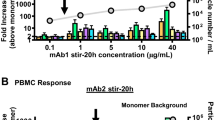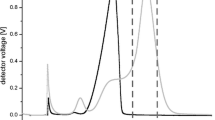Abstract
The capacity of protein aggregates to enhance immune responses to the monomeric form of the protein has been known for over a half-century. Despite the clear connection between protein aggregates and antibody mediated adverse events in treatment with early therapeutic protein products such as intravenous immune globulin (IVIG) and human growth hormone, surprisingly little is known about the nature of the aggregate species responsible for such effects. This review focuses on a framework for understanding how aggregate species potentially interact with the immune system to enhance immune responses, garnered from basic immunologic research. Thus, protein antigens presented in a highly arrayed structure, such as might be found in large nondenatured aggregate species, are highly potent in inducing antibody responses even in the absence of T-cell help. Their potency may relate to the ability of multivalent protein species to extensively cross-link B-cell receptor, which (1) activates B cells via Bt kinases to proliferate, and (2) targets protein to class II major histocompatability complex (MHC)-loading compartments, efficiently eliciting T-cell help for antibody responses. The review further focuses on protein aggregates as they affect an immunogenicity risk assessment, the use of animal models and studies in uncovering effects of protein aggregates, and changes in product manufacture and packaging that may affect generation of protein aggregates.
Similar content being viewed by others
References
Dintzis R, Okajima M, Middleton M, Greene G, Dintzis H. The immunogenicity of soluble haptenated polymers is determined by molecular mass and hapten valence.J Immunol. 1989;143:1239–1244.
Vos Q, Lees A, Wu ZQ, Snapper CM, Mond JJ. B-cell activation by T-cell-independent type 2 antigens as an integral part of the humoral immune response to pathogenic microorganisms.Immunol Rev. 2000;176:154–170.
Bachmann M, Zinkernagel R. Neutralizing antiviral B-cell responses.Annu Rev Immunol. 1997;15:235–270.
Fluckiger AC, Li Z, Kato RM, et al. Btk/Tec kinases regulate sustained increases in intracellular Ca2+ following B-cell receptor activation.EMBO J. 1998;17:1973–1985.
Ito H-O, Nakashima T, So T, Hirata M, Inoue M. Immunodominance of conformation-dependent B-cell epitopes of protein antigens.Biochem Biophys Res Commun. 2003;308:770–776.
Nath A, Hall E, Tuzova M, et al. Autoantibodies to Amyloid β-peptide (Aβ) are increased in Alzheimer’s disease patients and Aβ antibodies can enhance Aβ neurotoxicity.Neuromolecular Med. 2003;3:29–39.
O’Nuallain B, Wetzel R. Conformational Abs recognizing a generic amyloid fibril epitope.Proc Natl Acad Sci USA. 2002;99:1485–1490.
Casadevall N, Nataf J, Viron B, et al. Pure red cell aplasia and anti-erythropoietin antibodies in patients treated with recombinant erythropoietin.N Engl J Med. 2002;346:469–475.
Li J, Yang C, Xia Y, et al. Thrombocytopenia caused by the development of antibodies to thrombopoietin.Blood. 2001;98:3241–3248.
Chackerian B, Lenz P, Lowy D, Schiller JT. Determinants of autoantibody induction by conjugated papillomavirus-like particles.J Immunol. 2002;169:6120–6126.
Cheng P, Steele C, Gu L, Song W, Pierce S. MHC class II antigen processing in B cells: accelerated intracellular targeting of antigens.J Immunol. 1999;162:7171–7180.
Frei P, Benacerraf B, Thorbecke GJ. Phagocytosis of the antigen, a crucial step in the induction of the primary response.Proc Natl Acad Sci USA. 1965;53:20–23.
Martin F, Oliver A, Kearney J. Marginal zone and B1 B cells unite in the early response against T-independent blood-borne particulate antigens.Immunity. 2001;14:617–629.
Weigle WO. Analysis of autoimmunity through experimental models of thyroiditis and allergic encephalomyelitis.Adv Immunol. 1980;30:159–273.
Goodnow CC. Transgenic mice and analysis of B-cell tolerance.Annu Rev Immunol. 1992;10:489–518.
Kyewski B, Derbinski J. Self-representation in the thymus: an extended view.Nat Rev Immunol. 2004;4:688–698.
Aalberse R, Platts-Mills T. How do we avoid developing allergy: modifications of the Th2 response from a B-cell perspective.J Allergy Clin Immunol. 2004;113:983–986.
Spiegelberg H, Horner A, Takabayashi K, Raz E. Allergen immunostimulatory oligodeoxynucleotide conjugate: a novel allergoid for immunotherapy.Curr Opin Allergy Clin Immunol. 2002;2:547–551.
Cleland J, Powell M, Shire SJ. The development of stable protein formulations: a close look at protein aggregation, deamidation, and oxidation.Crit Rev Ther Drug Carrier Syst. 1993;10:307–377.
Wang W. Instability, stabilization, and formulation of liquid protein pharmaceuticals.Int J Pharm. 1999;185:129–188.
Shire SJ, Shahrokh Z, Liu J. Challenges in the development of high protein concentration formulationsJ Pharm Sci. 2004;93:1390–1402.
Hermeling S, Schellekens H, Crommelin DJ, Jiskoot W. Micelle-associated protein in epoetin formulations: a risk factor for immunogenicity?Pharm Res. 2003;20:1903–1907.
Baert F, Noman M, Vermeire S, et al. Influence of immunogenicity on the long term efficacy of infliximab in Crohn’s disease.N Engl J Med. 2003;348:601–608.
Ring J, Stephan W, Brendel W. Anaphylactoid reactions to infusions of plasma protein and human serum albumin.Clin Allergy. 1979;9:89–97.
Dresser DW. Specific inhibition of antibody production. II. Paralysis induced in adult mice by small quantities of protein antigen.Immunology. 1962;5:378–388.
Gamble CN. The role of soluble aggregates in the primary immune response of mice to human gamma globulin.Int Arch Allergy Appl Immunol. 1966;30:446–455.
Getahun A, Heyman B. How antibodies act as natural adjuvants.Immunol Lett. 2006;104:38–45.
Braun A, Kwee L, Labow MA, Alsenz J. Protein aggregates seem to play a key role among the parameters influencing the antigenicity of interferon alpha (IFN-alpha) in normal and transgenic mice.Pharm Res. 1997;14:1472–1478.
Barandun S, Kistler P, Jeunet F, Isliker H. Intravenous administration of human γ-globulin.Vox Sang. 1962;7:157–174.
Ellis E, Henney C. Adverse reactions following administration of human gamma globulin.J Allergy. 1969;43:45–54.
Moore W, Leppert P. Role of aggregated human growth hormone (hGH) in development of antibodies to hGH.J Clin Endocrinol Metab. 1980;51:691–697.
Staff PDR, ed. Proleukin. In:2004 Physicians Desk Reference. 58th ed. Montvale, NJ: Thomson Health care; 2004;1163–1167.
Prummer O. Treatment-induced antibodies to interleukin 2.Biotherapy. 1997;10:15–24.
Ishiguro A, Nakahata T, Matsubara K, et al. Age-related changes in thrombopoietin in children: reference interval for serum thrombopoietin levels.Br J Haematol. 1999;106:884–888.
Novotny J, Handschumacher M, Haber E, et al. Antigenic determinants in proteins coincide with surface regions accessible to large probes (antibody domains).Proc Natl Acad Sci USA. 1986;83:226–230.
Li P, Azizul H, Blum J. Role of disulfide bonds in regulating antigen processing and epitope selection.J Immunol. 2002;169:2444–2450.
Alliance Protein Laboratories Web site. Summary of characterization methods offered. Available at: http://www.ap-lab.com/characterization_methods.htm. Accessed July 6, 2006.
Liu J, Shire SJ. Analytical ultracentrifugation in the pharmaceutical industry.J Pharm Sci. 1999;88:1237–1241.
Wyatt Technology corporation Web site. Theory. Available at: http://www.wyatt.com/theory/index.cfin. Accessed July 6, 2006.
Koppaka V, Murray P, Axelsen P. Early synergy between Abeta 42 and oxidatively damaged membranes in promoting amyloid fibril formation by Abeta40.J Biol Chem. 2003;278:36277–36284.
Levin S. Field flow fractionation in biomedical analysis.Biomed Chromatogr. 1991;5:133–137.
Fraunhofer W, Winter G, Coester C. Asymmetrical flow field-flow fractionation and multiangle light scattering for analysis of gelatin nanoparticle drug carrier systems.Anal Chem. 2004;76:1909–1920.
Boven K, Stryker S, Knight J, et al. The increased incidence of pure red cell aplasia with an Eprex formulation in uncoated rubber stopper syringes.Kidney Int. 2005;67:2346–2353.
Peerlinck K, Arnout J, Di Giambattista M, et al. Factor VIII inhibitors in previously treated hemophilia A patients with a double virus inactivated plasma derived factor VIII concentrate.Thromb Haemost. 1997;77:80–86.
Author information
Authors and Affiliations
Corresponding author
Additional information
Published: August 4, 2006
Rights and permissions
About this article
Cite this article
Rosenberg, A.S. Effects of protein aggregates: An immunologic perspective. AAPS J 8, 59 (2006). https://doi.org/10.1208/aapsj080359
Received:
Accepted:
Published:
DOI: https://doi.org/10.1208/aapsj080359




